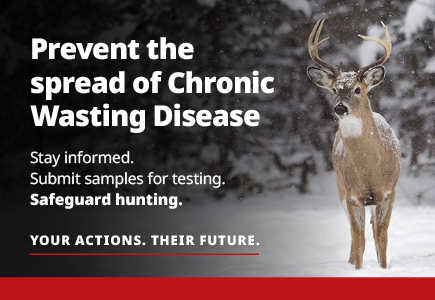Chronic Wasting Disease (CWD) is a fatal disease of the central nervous system of deer, elk, moose and caribou, members of the cervid (deer) family. The disease is caused by one or more strains of self-propagating proteins, called prions. The prions, once transmitted, begin to propagate, first in the immune system (lymph nodes and tonsils) and later, in the brain, spinal cord and other organs. This disease belongs to a group of diseases called transmissible spongiform encephalopathies (TSEs). TSEs tend to be species-specific and scientists believe that most are not naturally transmissible between different species.
What are the disease symptoms and can an infected animal be cured?
In early stages, infected animals can appear normal, while also spreading the disease. As the disease progresses, animals tend to be less alert, and fearful, with a general unhealthy look and obvious weight loss. As it progresses, infected animals become very thin and uncoordinated, with drooping ears and heads, are unaware of their surroundings and often have excessive drooling. At this point, death is near.
There is no cure for CWD. It is always fatal, with animals dying typically within two to three years and sometimes, as long as five years or more from the time of infection.
How is CWD spread?
Infected animals can shed prions in saliva, feces, urine, and possibly, even after death, through their remains. Animals are infected by direct (animal-to-animal) contact transmission or by indirect transmission from prions deposited in the environment. It should be noted that prions can survive in the environment for an extended period of time (e.g., possibly five years or more.)
Can people, or livestock, get CWD?
Currently, there is no direct evidence that CWD can be spread to humans or animals, other than members of the deer family, though the science is still developing in this area. The World Health Organization (WHO), Health Canada, US Centers for Disease Control and Prevention (CDC), and numerous other public health agencies recommend against eating meat from CWD-positive animals. Available data suggest that risk of transmission to humans is low, but it is not zero. These public health agencies also recommend against feeding meat or other parts of CWD-infected cervids to other animals.




